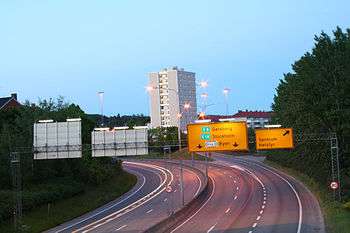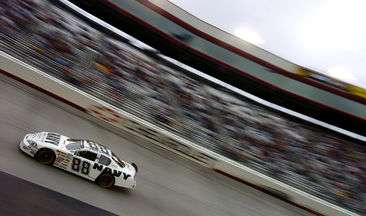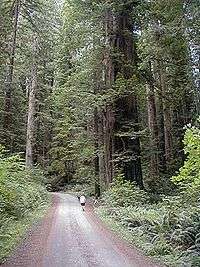Fundamentals of Transportation/Horizontal Curves
< Fundamentals of TransportationHorizontal Curves are one of the two important transition elements in geometric design for highways (along with Vertical Curves). A horizontal curve provides a transition between two tangent strips of roadway, allowing a vehicle to negotiate a turn at a gradual rate rather than a sharp cut. The design of the curve is dependent on the intended design speed for the roadway, as well as other factors including drainage and friction. These curves are semicircles as to provide the driver with a constant turning rate with radii determined by the laws of physics surrounding centripetal force.
Fundamental Horizontal Curve Properties
Physics Properties

Aside from momentum, when a vehicle makes a turn, two forces are acting upon it. The first is gravity, which pulls the vehicle toward the ground. The second is centrifugal force, for which its opposite, centripetal force, an external force, is required to keep the vehicle on a curved path. For any given velocity, the centripetal force needs to be greater for a tighter turn (one with a smaller radius) than a broader one (one with a larger radius). On a level surface, side friction serves as a countering force to the centrifugal force, but it generally provides very little resistance/force. Thus, a vehicle has to make a very wide circle in order to make a turn on the level.
Given that road designs usually are limited by very narrow design areas, wide turns are generally discouraged. To deal with this issue, designers of horizontal curves incorporate roads that are tilted at a slight angle. This tilt is defined as superelevation, or , which is the amount of rise seen on an angled cross-section of a road given a certain run, otherwise known as slope. The presence of superelevation on a curve allows some of the centripetal force to be countered by the ground, thus allowing the turn to be executed at a faster rate than would be allowed on a flat surface. Superelevation also plays another important role by aiding in drainage during precipitation events, as water runs off the road rather than collecting on it. Generally, superelevation is limited to being less than 14 percent, as engineers need to account for stopped vehicles on the curve, where centripetal force is not present.
The allowable radius for a horizontal curve can then be determined by knowing the intended design velocity , the coefficient of friction, and the allowed superelevation on the curve.
With this radius, practitioners can determine the degree of curve to see if it falls within acceptable standards. Degree of curve, , can be computed through the following formula, which is given in Metric.
Where:
- = Degree of curve [angle subtended by a 30.5-m (100 ft) arc along the horizontal curve
Application of Superelevation

One place you will see steep banking is at automobile racetracks. These tracks do not operate in winter, and so can avoid the problems of banking in winter weather. Drivers are also especially skilled, though crashes are not infrequent. For NASCAR fans, the following table may be of interest.
Table: Banking at US Racetracks
| Track | Length (miles) | Banking (degrees) |
| Chicago Motor Speedway | 1 | 0.00 |
| Infineon Raceway | 1.949 | |
| Watkins Glen International | 2.45 | |
| Pocono Raceway | 2.5 | 6.00 |
| Homestead-Miami Speedway | 1.5 | 8.00 |
| Indianapolis Motor Speedway | 2.5 | 9.00 |
| Memphis Motorsports Park | 0.75 | 11.00 |
| Phoenix International Raceway | 1 | 11.00 |
| Las Vegas Motor Speedway | 1.5 | 12.00 |
| Martinsville Speedway | 0.526 | 12.00 |
| New Hampshire Int'l Speedway | 1.058 | 12.00 |
| California Speedway | 2 | 14.00 |
| Kentucky Speedway | 1.5 | 14.00 |
| Richmond International Raceway | 0.75 | 14.00 |
| Kansas Speedway | 1.5 | 15.00 |
| Michigan International Speedway | 2 | 18.00 |
| Nashville Speedway USA | 0.596 | 18.00 |
| North Carolina Speedway | 1.017 | 22.00 |
| Darlington Raceway | 1.366 | 23.00 |
| Atlanta Motor Speedway | 1.54 | 24.00 |
| Dover Downs Int'l Speedway | 1 | 24.00 |
| Lowe's Motor Speedway | 1.5 | 24.00 |
| Texas Motor Speedway | 1.5 | 24.00 |
| Daytona International Speedway | 2.5 | 31.00 |
| Talladega Superspeedway | 2.66 | 33.00 |
| Bristol Motor Speedway | 0.533 | 36.00 |
Source: Fantasy Racing Zone by FSN
Geometric Properties
Horizontal curves occur at locations where two roadways intersect, providing a gradual transition between the two. The intersection point of the two roads is defined as the Point of Tangent Intersection (PI). The location of the curve's start point is defined as the Point of Curve (PC) while the location of the curve's end point is defined as the Point of Tangent (PT). The PC is a distance from the PI, where is defined as Tangent Length. Tangent Length can be calculated by finding the central angle of the curve, in degrees. This angle is equal to the supplement of the interior angle between the two road tangents.
Where:
- = tangent length (in length units)
- = central angle of the curve, in degrees
- = curve radius (in length units)
The PT is a distance from the PC where is defined as Curve Length. Curve length can be determined using the formula for semicircle length:
The distance between the PI and the vertex of the curve can be easily calculated by using the property of right triangles with and . Taking this distance and subtracting off the curve radius , the external distance , which is the smallest distance between the curve and PI, can be found.
Where:
- = external distance (in length units)
Similarly, the middle ordinate can be found. The middle ordinate is the maximum distance between a line drawn between PC and PT and the curve. It falls along the line between the curve's vertex and the PI.
Where:
- = middle ordinate (in length units)
Similarly, the geometric formula for chord length can find , which represents the chord length for this curve.
Sight Distance Properties

Unlike straight, level roads that would have a clear line of sight for a great distance, horizontal curves pose a unique challenge. Natural terrain within the inside of the curve, such as trees, cliffs, or buildings, can potentially block a driver's view of the upcoming road if placed too close to the road. As a result, the acceptable design speed is often reduced to account for sight distance restrictions.
Two scenarios exist when computing the acceptable sight distance for a given curve. The first is where the sight distance is determined to be less than the curve length. The second is where the sight distance exceeds the curve length. Each scenario has a respective formula that produces sight distance based on geometric properties. Determining which scenario is the correct one often requires testing both to find out which is true.
Given a certain sight distance and a known curve length and inner lane centerline radius , the distance a sight obstraction can be from the interior edge of the road, can be computed in the following formulas.
Demonstrations
- Flash animation: Roadside Clear Zone (by Karen Dixon and Thomas Wall)
- Flash animation: Superelevation (by Karen Dixon and Thomas Wall)
Examples
Example 1: Curve Radius
Problem:
A curving roadway has a design speed of 110 km/hr. At one horizontal curve, the superelevation has been set at 6.0% and the coefficient of side friction is found to be 0.10. Determine the minimum radius of the curve that will provide safe vehicle operation.
Solution:
Example 2: Determining Stationing
Problem:
A horizontal curve is designed with a 600 m radius and is known to have a tangent length of 52 m. The PI is at station 200+00. Determine the stationing of the PT.
Solution:
Example 3: Stopping Sight Distance
Problem:
A very long horizontal curve on a one-directional racetrack has 1750-meter centerline radius, two 4-meter lanes, and a 200 km/hr design speed. Determine the closest distance from the inside edge of the track that spectators can park without impeding the necessary sight distance of the drivers. Assume that the sight distance is less than the length of the curve, a coefficient of friction of 0.3, and a perception-reaction time of 2.5 seconds.
Solution:
With a centerline radius of 1750 meters, the centerline of the interior lane is 1748 meters from the vertex (1750 - (4/2)). Using the stopping sight distance formula (See Sight Distance), SSD is computed to be 664 meters. With this, the distance from the track that spectators can be parked can easily be found.
This gives the distance (31.43 m) to the center of the inside lane. Subtracting half the lane width (2m in this case) would give the distance to the edge of the track, 29.43 m.
Thought Question
Problem
Horizontal curves are semicircles, as to allow the driver to negotiate the curve without having to change the tilt of the wheel while passing through. However, what happens at the PC or PT, where tangent road transitions to a curve or vice versa. Is the driver expected to abruptly turn the wheel to match the curve or tangent?
Solution
Generally not. Engineers employ several techniques to allow drivers to gradually turn the wheel as they enter or leave the curve. One of the more popular ways is to use Splines. Splines are polynomial curves that have changing rates of curvature. Employed at the PC and PT, Splines take away any sharp changes for the drivers and make the drive a more pleasant one.
Sample Problem
Demonstrations
Additional Questions
Variables
- - Centerline Curve Radius
- - Degree of curve [angle subtended by a 30.5-m (100 ft) arc along the horizontal curve
- - tangent length (in length units)
- - central angle of the curve, in degrees
- - Smallest distance between the curve and PI
- - Middle ordinate
- - Curve Length
- - Cord Length
- - Sight Distance
- - Acceptable distance from inner edge of road for a sight obstruction to be placed without impeding sight distance
- - Radius of innermost lane centerline
Key Terms
- PC: Point of Curve
- PI: Point of Tangent Intersect
- PT: Point of Tangent